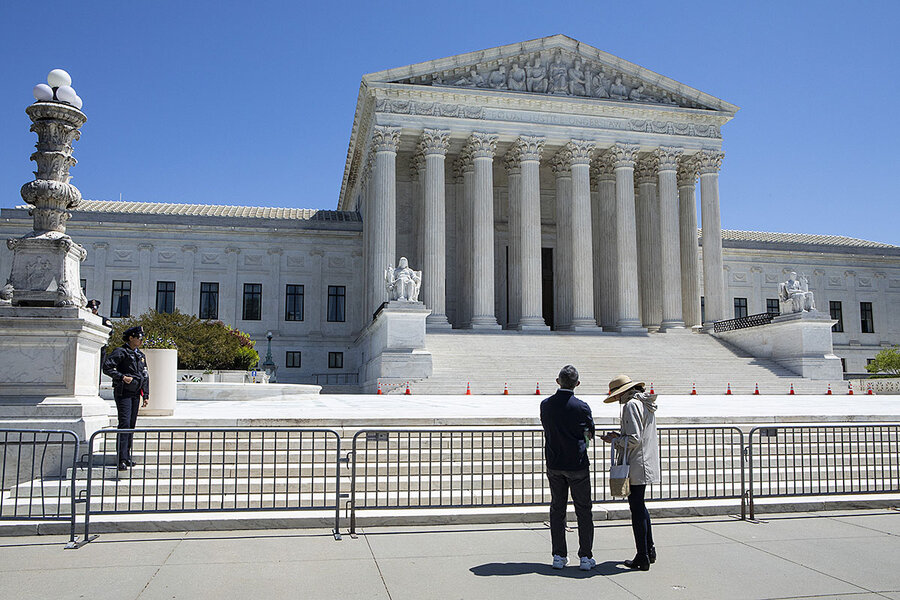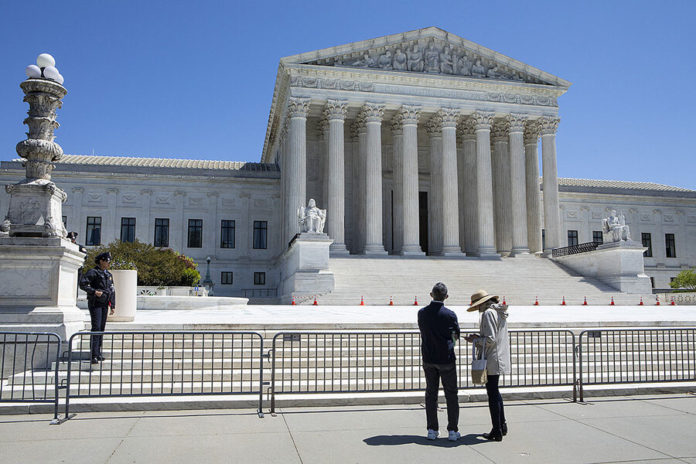
Tarahrick Terry’s case is, broadly, a story about regret and redemption. But it’s also a story about how the specific wording in a law can quickly breed confusion in the courts.
The sentencing rule that treated crack cocaine 100 times worse than powder had been in effect for 20 years by the time Mr. Terry was sentenced in 2008.
Why We Wrote This
The sentencing rule treating crack cocaine as 100 times worse than powder is seen by bipartisan critics as a punitive remnant of the war on drugs. The Supreme Court on Tuesday will hear a case that could deliver a telling blow – or a telling victory – for reform.
The disparity has come to be viewed, by critics spanning the political spectrum, as one of the great injustices of the war on drugs. It’s been one of the key drivers of mass incarceration, those critics say, in particular subjecting thousands of low-level offenders – the vast majority young people of color – to long prison terms.
In the past decade Congress has reduced almost all of those sentences – all except for Mr. Terry and thousands of low-level crack offenders like him.
It’s a deferral of justice that has brought him into an unlikely alliance with congressional leaders from both parties, as well as former federal judges, prosecutors, and, latterly, the Biden administration.
On Tuesday it will bring him to the U.S. Supreme Court, when the justices will hear arguments on whether this vestige of another era should be eliminated.
Irving, Texas
It was 2008, and coming off his second run-in with the law, Tarahrick Terry wanted to make some money.
A week shy of his 21st birthday, he had four grams of crack cocaine in his pocket – something of an early present. But two undercover Miami cops ensured he couldn’t cash in.
He pleaded guilty and asked the judge for forgiveness. The judge sentenced him to 188 months in federal prison, and Mr. Terry’s been there ever since.
Why We Wrote This
The sentencing rule treating crack cocaine as 100 times worse than powder is seen by bipartisan critics as a punitive remnant of the war on drugs. The Supreme Court on Tuesday will hear a case that could deliver a telling blow – or a telling victory – for reform.
If he’d had four grams of powder cocaine, he could have been released by now. But Mr. Terry’s punishment followed war-on-drugs-era federal guidelines that treated a gram of crack cocaine 100 times worse than a gram of powder cocaine.
The sentencing disparity has come to be viewed, by critics spanning the political spectrum, as one of the great injustices of the war on drugs. It’s been one of the key drivers of mass incarceration, those critics say, in particular subjecting thousands of low-level offenders – the vast majority young people of color – to long prison terms.
In the past decade Congress has reduced almost all of those sentences – all except for Mr. Terry, and thousands of low-level crack offenders like him. It’s a deferral of justice that has brought him into an unlikely alliance with congressional leaders from both parties, as well as former federal judges, prosecutors, and, latterly, the Biden administration.
On Tuesday it will bring him to the U.S. Supreme Court, when the justices will hear arguments on whether this vestige of the tough-on-crime era should be eliminated. His case is relatively narrow and technical, but in a country – and a Congress – that has come to roundly condemn drug policies like the crack powder sentencing disparity, it’s significant.
“Crack cocaine has really been the example for the injustices of the entire criminal justice system,” says Kara Gotsch, deputy director of The Sentencing Project.
“Despite the symbolic enormity of this problem, we continue to struggle with ending racial disparity and racial injustice in our justice system,” she adds. “This case is a reminder of how far we still have to go.”
Regret and redemption
Mr. Terry’s case is, broadly, a story about regret and redemption. But it’s also a story about how the specific wording in a law can quickly breed confusion in the courts.
By 2002, the 100-to-1 sentencing rule had been in effect for 14 years, and the unintended consequences were becoming apparent.
The federal prison population had more than tripled to over 163,000, according to the U.S. Bureau of Prisons. The average sentence for a federal crack offense was almost 60% longer than the average sentence for a federal powder cocaine offense, the U.S. Sentencing Commission reported. And those sentences disproportionately impacted racial minorities, in particular Black Americans.
Congress responded in 2010 with the Fair Sentencing Act. The law shrank the disparity from 100-to-1 to 18-to-1 – but it only applied to future offenses, leaving anyone sentenced prior to 2010 unaffected. In 2018, with the First Step Act, Congress made the sentencing amendments in the Fair Sentencing Act retroactive.
As people began to ask for sentence reductions under the First Step Act, however, a problem began to emerge.
The 2010 law had amended sentences for mid- and high-level crack offenses, but never explicitly amended sentences for low-level offenses. So despite the 2018 law, sentences for low-level offenses – according to some courts – are still unchanged from when Congress implemented the 100-to-1 rule in 1986.
Essentially, people convicted of trafficking large amounts of crack cocaine are eligible for a reduced sentence under the First Step Act, but people convicted of trafficking small amounts aren’t.
“That position is not only peculiar; it is textually untenable,” wrote Mr. Terry’s lawyers in his brief. By amending the other two tiers, the act effectively modified the lowest tier too, they argue. “This case is that simple.”
Progressive and conservative legal organizations have filed briefs backing him; the lead sponsors of the First Step Act – two Democratic and two Republican U.S. senators – filed a brief emphasizing that their law applied “for crack-cocaine offenses across the board.” And after the Trump administration initially opposed Mr. Terry, the Biden administration reversed the government’s position in March.
Dueling definitions of textualism
With the withdrawal of the Justice Department in March, an amicus curiae lawyer is now opposing Mr. Terry. He argues that the First Step Act clearly excludes people like Mr. Terry, and that they have other mechanisms available to ask for reduced sentences.
Indeed, the justices will likely scrutinize the specific wording of the statutes at issue. And the case is likely to bring into play an ongoing debate between the justices – particularly the six conservatives: how they apply textualism, a judicial method of interpreting laws based on the “ordinary meaning” of the text.
For example, the case could reignite the kind of quarrels seen in a landmark gay rights ruling last year.
In that ruling, Justice Neil Gorsuch – a conservative appointed by then-President Donald Trump – used textualism to conclude that employees could not be fired simply because they’re gay or transgender. In a dissent, his conservative colleague Justice Samuel Alito said the ruling “sails under a textualist flag” but was, perversely, “legislation.”
“It’ll be interesting to see how this range of justices sort through where the policy clearly points in one direction and the text sort of points in another,” says Douglas Berman, a professor at the Ohio State University Moritz College of Law and author of the Sentencing Law and Policy blog.
And on criminal justice policy generally, this case could indicate if the Supreme Court is shifting in a similar direction as the public, which now favors a softer hand with criminal defendants.
“The court’s criminal justice work this term, and in terms to come, are going to be a development of a narrative about whether the Trump justices are going to redefine what it means to be conservative when it comes to criminal justice cases,” says Professor Berman.
A question of equal justice
In the 1980s, crack cocaine was the fast nickel drug business to powder cocaine’s slow dime – cheap and quick to make, and easy to sell for profit.
By the mid-’80s there were open-air markets in cities around the country, igniting violent turf wars between gangs. The mistaken belief that crack was more dangerous and addictive than other drugs drove the country to demand a punitive response.
Black communities voiced those demands as well, but as the law enforcement response focused increasingly on young, low-level dealers in their communities, the cure soon became as bad as the disease.
“It rent the fabric, economically and socially, of the [Black] community,” says Donna Murch, a professor of history at Rutgers, the state university of New Jersey. “It led to lifelong economic marginalization.”
It rent apart the small community around William Curtis.
He was selling pizzas in the late 1990s, and getting beat up and robbed for it, when he decided he could face the same risk but make more money selling crack. He became a low-level dealer, selling $20 and $50 rocks in southern Illinois. He hadn’t heard of the 100-to-1 rule until he was sentenced under it in 1999.
He regrets his actions, he says – the children of the parents he supplied are whom he feels for most – but he feels the punishment he deserved has become injustice.
He’s out on home confinement now, due to the pandemic, but still has over a year on his sentence. He’s missed his brother’s funeral, and watching his children grow up and graduate. He’s watched violent criminals enter and leave, and he’s watched others with crack sentences get their prison time reduced.
“My family has missed out on a whole lot of life and being with me, and I’ve missed out on a whole lot of life and being with them,” says Mr. Curtis.
“I know I wronged, I know I deserved to go to prison,” he adds. “But the criminal justice system should be just that – just – and it wasn’t.”
Mr. Terry has similar regrets. He’d been taught how to sell drugs “from an early age,” he told the judge in 2008, and he would never sell or use drugs again. While in prison, he earned his GED certificate and took classes on parenting, real estate, and creative writing – all things that would weigh in his favor if a judge considers reducing his sentence.
But whether he is allowed to ask a judge to make that consideration now lies with the Supreme Court. As the country seeks to heal itself of the excesses of the war on drugs, the justices are in a position to deliver a telling blow, or a telling victory, to those aims.
A victory for Mr. Terry “would be progress in a larger [justice reform] movement, but also relief for the people who are serving these sentences,” says Ms. Gotsch.
“At the end of the day this is about people,” she adds, “and making sure our system of justice is fair and proportional.”







